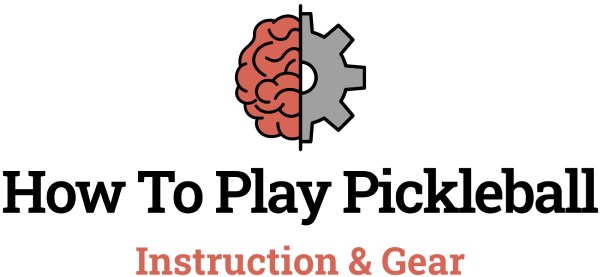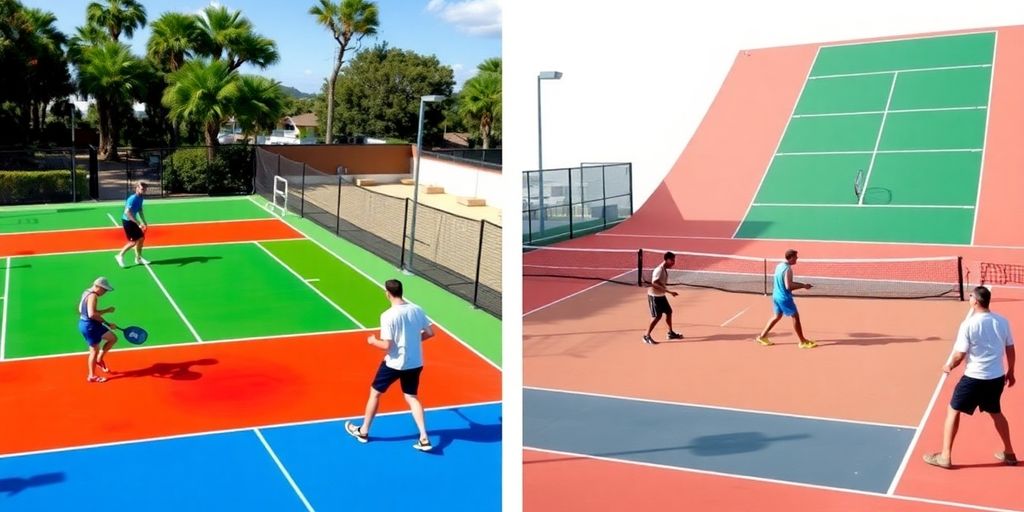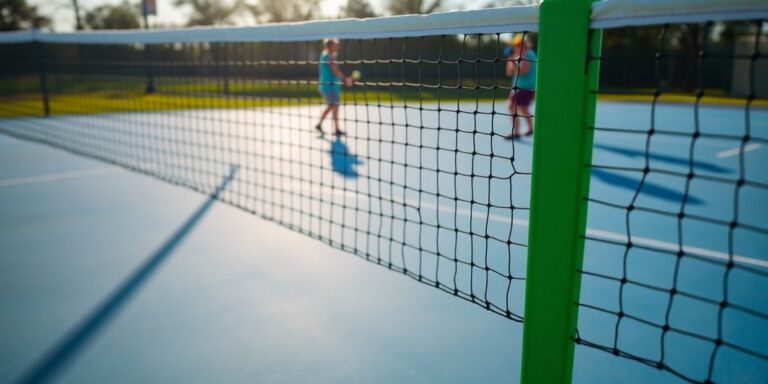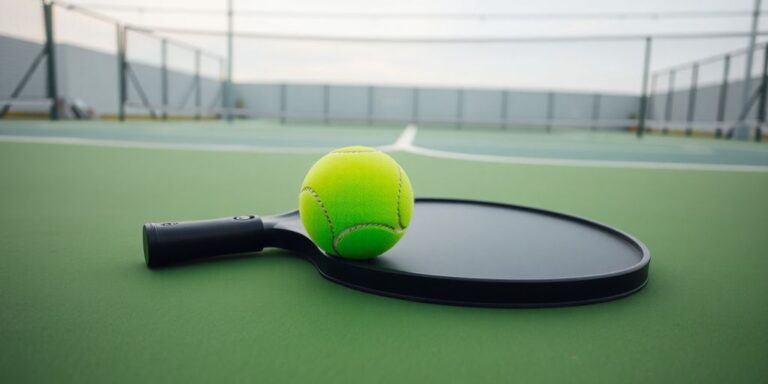So, you’ve probably heard of tennis, right? It’s been around forever, and everyone knows it. But have you heard about pickleball? It’s kind of like tennis’s younger cousin. Both sports are fun and active, but they have some pretty big differences. If you’re curious about how these two stack up, you’re in the right place. Let’s break down what makes pickleball and tennis unique and how they each bring something special to the court.
Key Takeaways
- Pickleball uses paddles and a plastic ball, while tennis uses rackets and a felt-covered ball. This changes how each game is played.
- Pickleball courts are smaller than tennis courts, which can make the game feel more accessible and less physically demanding.
- The scoring systems are different: pickleball games go to 11 points, while tennis uses a more complex system with games, sets, and matches.
- Pickleball is often seen as easier to learn, making it popular among beginners and older adults looking for a low-impact sport.
- Both sports offer great health benefits, but pickleball’s slower pace can be more inviting for casual play and social interaction.
Understanding the Equipment Differences
Paddles vs. Rackets
When stepping onto a pickleball court, you’ll notice players wielding paddles instead of traditional rackets. Pickleball paddles are solid and can be made from materials like wood, composite, or graphite. They’re wider and have a flat, square-shaped hitting surface, making them quite different from the stringed rackets used in tennis. Tennis rackets, typically made from graphite, aluminum, or carbon fiber, have strings that provide the tension needed to hit the heavier, pressurized tennis balls.
Ball Characteristics
The ball used in pickleball is a lightweight, perforated plastic ball, often resembling a wiffle ball. This design ensures controlled play and allows for engaging rallies. In contrast, tennis balls are covered in felt and are considerably heavier, designed for high-speed play and an exhilarating bounce.
Net Height and Width
Another key difference between the two sports is the net. In pickleball, the net is lower, standing at 34 inches in the center and 36 inches at the posts. Tennis nets are typically higher, at 36 inches in the center and 42 inches at the posts. The difference in net height influences the style of play, with pickleball encouraging more volleys and close-to-the-net action compared to tennis.
The equipment differences between pickleball and tennis not only shape how the games are played but also influence the techniques and strategies players must develop. Mastering these tools is essential to excelling in either sport.
For those interested in how pickleball courts are smaller than tennis courts, this size difference contributes to faster gameplay and demands more strategic positioning.
Court Size and Layout
Dimensions of Pickleball Courts
Pickleball courts are notably compact, measuring 20 feet wide by 44 feet long. This size is similar to a doubles badminton court, allowing for a more intimate and fast-paced game. The smaller dimensions mean players are closer together, which can lead to quick exchanges and a focus on strategy and precision over raw power. The absence of doubles alleys, unlike in tennis, means that pickleball courts are designed for both singles and doubles play without any modifications.
Dimensions of Tennis Courts
In contrast, tennis courts are significantly larger. A standard tennis court measures 78 feet in length and varies in width: 27 feet for singles matches and 36 feet for doubles. This larger size offers more room for players to maneuver and execute powerful shots, making the game more about endurance and speed. The presence of doubles alleys adds complexity, requiring players to cover more ground and adapt their strategies accordingly.
Impact on Gameplay
The difference in court sizes between pickleball and tennis has a profound impact on how each game is played. Pickleball’s smaller court encourages a game that is quick and tactical, with players often engaging in rapid volleys and strategic shot placements. On the other hand, tennis, with its larger court, allows for longer rallies and a greater emphasis on baseline play. Players need to have strong endurance and the ability to cover a lot of ground quickly.
The distinct court sizes in pickleball and tennis not only shape how the games are played but also influence the skills and strategies that players develop. While tennis players might focus on power and endurance, pickleball players often hone their precision and tactical thinking.
Gameplay and Scoring Systems
Pickleball Scoring Rules
Pickleball’s scoring system is pretty straightforward, which makes the game easy to pick up. Points can only be scored by the serving team, and matches are usually played to 11, 15, or 21 points. This rule keeps the game tight and often leads to exciting finishes. If the score reaches a tie, like 10-10, a team has to win by two points to claim victory. This ensures that every point matters, keeping players on their toes throughout the match. For a deeper dive into pickleball scoring systems, this guide provides an excellent breakdown.
Tennis Scoring Rules
Tennis, on the other hand, uses a more layered scoring system. Points are awarded as 15, 30, 40, and then game point. If both players reach 40, it’s called deuce, and a player must win by two consecutive points to win the game. A set is won by a player who first wins six games, with at least a two-game lead. Matches are usually the best of three or five sets, adding a strategic depth that can really change the flow of the game. This complexity can make tennis thrilling, with momentum swings that keep both players and spectators engaged.
Serving Techniques
When it comes to serving, pickleball and tennis couldn’t be more different. In pickleball, serves are underhand, which sets a more strategic tone to the game. This style encourages players to focus on placement and strategy rather than sheer power. Tennis serves are typically overhead and can reach impressive speeds, often turning the serve into a powerful weapon. This difference in serving style shapes the overall gameplay of each sport, with pickleball leaning towards tactical exchanges and tennis often showcasing power and precision. For those looking to refine their pickleball skills, including serving techniques, this comprehensive guide is a valuable resource.
Accessibility and Popularity
Ease of Learning for Beginners
Pickleball is often seen as the easier sport to pick up, especially for those new to racket sports. The rules are straightforward, and the game is less physically demanding compared to tennis. This makes pickleball a go-to choice for beginners, particularly older adults who might find tennis a bit too intense. The smaller court and lighter equipment mean you don’t have to run as much, and you can focus more on having fun than on mastering complex techniques.
Demographic Appeal
When it comes to who plays these sports, pickleball and tennis attract slightly different crowds. Pickleball is rapidly gaining popularity among all ages but is especially loved by seniors who appreciate its social nature and relaxed pace. Tennis, on the other hand, is often associated with younger, more competitive players who enjoy the challenge and athleticism involved. But don’t be fooled—both sports have their die-hard fans across all age groups.
Growth Trends
The growth of pickleball has been nothing short of explosive, with a reported growth rate of over 21% in just one year. Its rise is fueled by its accessibility and the sense of community it fosters. Tennis, while still incredibly popular worldwide, doesn’t quite match the rapid expansion of pickleball. However, both sports continue to thrive, each carving out its own niche in the world of racket sports. As pickleball continues to grow, it’s clear that its appeal lies in its simplicity and inclusive nature, making it a sport for everyone.
Health and Fitness Benefits
Physical Health Advantages
Pickleball and tennis both offer great physical health benefits, but they do so in different ways. Playing pickleball is a fantastic low-impact exercise, making it perfect for people of all ages, especially seniors. This sport is gentle on the joints, thanks to its smaller court and lighter paddles, which means less stress on your knees and hips. Tennis, on the other hand, provides a more intense workout. With its larger court, players get a full-body workout, enhancing cardiovascular health and muscle strength.
Here’s a quick comparison:
| Aspect | Pickleball | Tennis |
|---|---|---|
| Impact Level | Low-impact | High-impact |
| Court Size | Smaller, less running | Larger, more running |
| Equipment | Lighter paddles | Heavier rackets |
Mental Health Benefits
Both sports are great for mental health, but pickleball has a slight edge due to its social nature. Playing pickleball can be a wonderful stress reliever. The friendly atmosphere and quick-paced games boost mood and mental well-being. Tennis also offers mental health benefits, such as improved focus and stress reduction, but the social aspect might not be as prominent as in pickleball.
Engaging in regular pickleball sessions can significantly improve one’s mood and cognitive functions. The dynamic and social gameplay keeps players mentally sharp while fostering a sense of community.
Low-Impact Exercise
For those looking for a workout that’s easy on the body, pickleball is the way to go. It’s a low-impact sport that allows players to stay active without putting too much strain on their bodies. This makes it an excellent choice for older adults or those recovering from injuries. Tennis, while offering a more vigorous workout, can be demanding on the body, which might not be suitable for everyone.
In conclusion, whether you’re seeking a gentle way to stay fit or a more intense physical challenge, both sports have something to offer. Consider your personal fitness goals and physical capabilities when choosing between them. If you’re interested in a low-impact workout that improves heart health, pickleball might be the perfect fit for you.
Social and Community Aspects

Building Community Connections
Pickleball and tennis are both popular social sports, each offering a unique atmosphere. Pickleball, in particular, is known for its welcoming vibe, making it attractive to a wide range of people. It’s not just about the game; it’s about the community. Players often gather for casual games, fostering friendships that go beyond the court. The doubles format in pickleball promotes a social environment, encouraging camaraderie among players. Whether you’re a seasoned player or a newcomer, there’s always room to connect and share the joy of the game.
Structured vs. Recreational Play
While tennis can be social, it often leans towards structured competitions, which might appeal to a more serious crowd. In contrast, pickleball thrives on its recreational nature. It’s designed for fun and flexibility, drawing in those who prefer lighthearted play over high-stakes matches. This makes pickleball an excellent choice for people looking to enjoy a sport without the pressure of intense competition.
Inclusivity and Diversity
Pickleball’s relaxed atmosphere enhances its appeal to players of all ages and backgrounds. The proximity of players on the court encourages interaction and community, making it a more social sport compared to tennis. This inclusivity is a big part of why pickleball is growing so fast. It’s not just a game; it’s a movement that brings people together, creating a diverse community that welcomes everyone. For tennis players seeking a different experience, pickleball offers a refreshing change with its emphasis on social interaction and community building.
Strategic and Tactical Differences

Shot Placement and Strategy
In both pickleball and tennis, where you place your shots can make or break your game. But the strategies differ due to the nature of the equipment and court. In pickleball, the lower net height allows players to use angles and placement more creatively. You can hit shots down the line or cross-court with less risk of hitting out. Tennis, on the other hand, often requires powerful shots aimed down the middle to minimize errors, especially given the higher net at the sides. Pickleball emphasizes finesse and control, rewarding players who can strategically place shots rather than rely solely on power.
Net Play and Volleys
Net play is crucial in both sports, but the tactics vary. Pickleball’s smaller court size and slower ball speed mean that players often engage in fast, close-quarters exchanges at the net. This encourages quick reflexes and strategic volleys. In tennis, players use volleys to finish points quickly, often following powerful serves or groundstrokes. The difference in net height and ball dynamics makes pickleball net play more about control and less about power.
Adapting Skills from Tennis to Pickleball
For those transitioning from tennis to pickleball, there’s a learning curve. The paddles used in pickleball are lighter and have no strings, which means the feel of the ball is different. Tennis players might initially struggle with the lack of power but will find that pickleball rewards strategic play and shot placement. The underhand serve in pickleball also requires a different technique, focusing on precision rather than power. Transitioning players often need to adjust their mindset, moving from a power-focused game to one that values control and tactics.
While both sports share similarities, the strategic differences highlight the unique challenges and rewards each offers. Pickleball’s emphasis on strategy over sheer power makes it an appealing choice for many, offering a fresh challenge even for seasoned tennis players.
Historical and Cultural Context
Origins of Pickleball
Pickleball, a sport born in 1965 on Bainbridge Island, Washington, started as a simple backyard game. It was the brainchild of three dads—Joel Pritchard, Bill Bell, and Barney McCallum—who wanted to entertain their kids. Armed with ping pong paddles, a plastic ball, and a badminton net, they crafted a game that was initially called "Paddle Rackets." The name "Pickleball" came later, inspired by the Pritchards’ dog, Pickles, who loved to chase the ball around. Over the years, this sport has evolved, combining elements from tennis, badminton, and table tennis, which adds to its unique charm. Today, pickleball has become a global sensation, with dedicated courts and leagues sprouting up worldwide.
Historical Evolution of Tennis
Tennis has a rich history that dates back to 12th century France, where it started as "jeu de paume," or "game of the palm." Originally played indoors with bare hands, the game gradually evolved as players began using gloves and wooden paddles. By the 16th century, it had captured the interest of European nobility and clergy, transitioning to the grassy lawns of England, laying the groundwork for modern lawn tennis. The rules and equipment saw significant standardization in the 19th century, largely due to Major Walter Clopton Wingfield’s efforts, who patented the first commercial version of lawn tennis in 1874. The sport’s prestige grew with the establishment of the All England Lawn Tennis and Croquet Club in 1868 and the inaugural Wimbledon Championship in 1877. Since then, tennis has flourished, becoming a global spectacle with major tournaments like the French Open and the US Open drawing millions of fans worldwide.
Cultural Impact and Global Reach
Pickleball and tennis, while distinct, share a cultural impact that resonates globally. Pickleball’s rapid rise in popularity, especially among older adults, highlights its appeal as a low-impact, community-driven sport. Its easy-to-learn nature makes it accessible to players of all ages, fostering social connections and inclusivity. Meanwhile, tennis remains a cornerstone of the international sports scene, celebrated for its rich heritage and the grandeur of its tournaments. Both sports offer unique experiences that attract diverse audiences, from casual players to elite athletes, each contributing to a vibrant global sports culture.
Understanding the historical and cultural background of pickleball can really enhance your game. It’s not just about hitting the ball; it’s about connecting with the sport’s roots and community. Dive deeper into this fascinating world and discover how it can improve your skills. For more insights and tips, visit our website!
Conclusion
So, there you have it. Pickleball and tennis, while both racquet sports, offer pretty different experiences. Tennis is like the classic, with its big courts and fast-paced action. It’s been around forever and has a certain prestige. Pickleball, on the other hand, is the new kid on the block. It’s more about strategy and less about power, making it a hit with folks of all ages. Whether you’re drawn to the tradition of tennis or the community vibe of pickleball, both sports have something unique to offer. In the end, it’s all about what you’re looking for in a game. So grab a paddle or a racket, and get out there!
Frequently Asked Questions
What is the main difference between pickleball and tennis equipment?
Pickleball uses paddles and a lightweight plastic ball, while tennis uses rackets and a heavier, felt-covered ball.
How does the scoring system differ in pickleball versus tennis?
Pickleball games are played to 11 points, with points scored by the serving team only. Tennis uses a more complex system with games, sets, and matches.
Which sport is easier for beginners to learn, pickleball or tennis?
Pickleball is often considered easier for beginners because it has simpler rules and a smaller court.
What are the health benefits of playing pickleball compared to tennis?
Both sports offer great physical exercise, but pickleball is lower-impact, making it easier on the joints.
Can skills from tennis be used in pickleball?
Yes, many skills like hand-eye coordination and strategic thinking are transferable from tennis to pickleball.
Why is pickleball becoming so popular?
Pickleball is growing in popularity because it’s easy to learn, fun to play, and accessible to people of all ages and skill levels.




